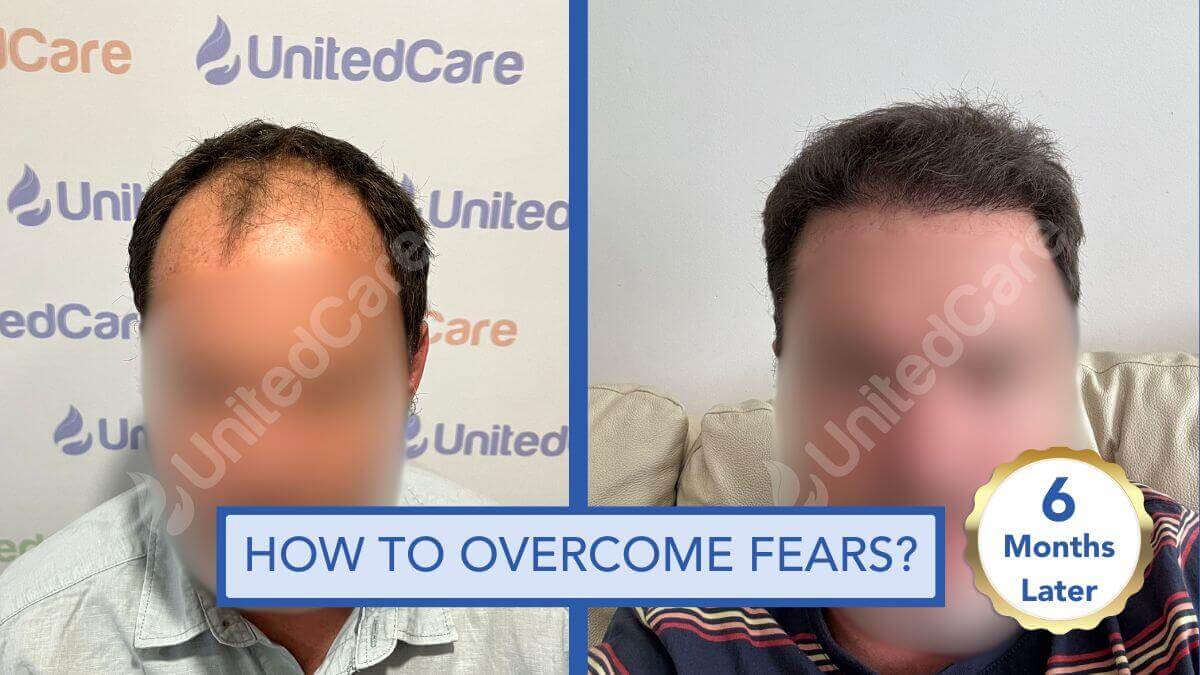Losing your hair… It hits you in weird ways. It’s not just hair falling out—it’s like losing a piece of yourself. You look in the mirror, and suddenly you’re not you anymore. Thoughts come to your mind: “Will people notice?” “What if the implants/hairline doesn’t look natural” “What if I look ridiculous with a transplant?”
You have 3 options to stop balding anxiety from eating your brain:
1️⃣ Accepting balding and cutting/shaving your hair accordingly.
2️⃣ Trying non-surgical solutions that are either ineffective or have side effects.
3️⃣ Having a hair transplant ( through which you let your more shedding-resistant hairs be transplanted to more aesthetically important zones)
If you’re scared of the third option “hair transplant” you’re not alone.
✅ But, don’t worry. Modern techniques make it much less invasive and painful than you think.
Table of Contents
Why Losing Your Hair Affects You So Much?
We tie youthfulness and attractiveness to thick hair. (Almost nobody is bald during childhood right)
So when it starts thinning, it feels like you are aging and your inner confidence is gone.
2020 study published in Dermatology and Therapy titled “The Psychological Impact of Androgenetic Alopecia: A Systematic Review.” found similar outcomes:
- 62% of men associated hair loss with aging and a decline in attractiveness.
- 47% reported feeling less confident in social/work settings due to thinning hair.
- Women also impacted, but men were more likely to tie hair to “masculinity” and youth.
I knew a guy who wore hats for four years straight because he thought baldness = “old.” He was just 25 by the way.
Additionally, I know my patients having hair loss issues reported that:
- They feel shy in social gatherings and can’t approach women any more.
- Avoiding photos or wear hats all the time.
- Obsessing over every stray hair falling in the shower.
🏥 So losing hair is a serious issue that needs a resolution.
What Freaks People Out About Hair Transplants?
So you finally think, “Okay, maybe I’ll get a transplant.” But then:
- “It’s gonna hurt?”
FUE or DHI whatever the technique, you imagine pain. Most clinics use local anesthesia; you feel tugging at most, and afterward some soreness, sure. The pain afterward can be handled by painkillers. If you are afraid of needles, sedation can also be applied by an anesthesiologist. - “What if it looks fake and unnatural?”
You’ve seen very bad hairlines that look like doll wigs. If you pick a bad doctor or cheap place, yeah, that could happen. But modern techniques—when done by an ISHRS-certified surgeon—can look natural. - “What if I waste $10K?”
Hair transplants aren’t cheap in England, the USA, or Canada. However, it is affordable in Turkey. At UnitedCare Clinic $4K is enough to get 5000 graft hair transplants done by a surgeon with the latest techniques. - “Friends will judge me.”
You worry people will say you’re vain, insecure, or obsessed with looks. But when they see the result, they’ll be also surprised and all of your balding friends will ask you about the clinic/doctor.
⚠️🏴☠️ WHAT ABOUT BOTCHED JOBS? Yes, they exist. And an insider info “99% of hair transplants in Turkey are done without the doctor”. So be careful!
How to Get Rid of Hair Transplant Anxiety?
Our brains love worst-case scenarios. And if you are swinging between “Let’s do it!” and “Oh god, no way”, you are not alone.
Don’t panic and say ok to a cheap clinic you found online. Do you research; went through the items in the list below:
1️⃣ Learn the process inside-out
Instead of just looking at bad hair transplant cases, find clinics’ patient galleries, watch YouTube interviews with surgeons, and read real doctor blogs. Knowledge soothes nerves.
2️⃣ Get multiple opinions and find an internationally certified surgeon
Don’t settle on the first clinic you are in contact with. Visit or contact three or four places. Ask every detail you want:
- Do the real surgeon perform the surgery?
- Does he/she do simultaneous surgeries? (Are you a hair mill?)
- Can I see 6-month, 12-month follow-up pics?
- What if I’m unhappy—what do you offer? Re-operation? Moneyback?
- Do you use bio-enhancements to boost the graft survival rate?
Ask to speak with the doctor himself/herself. If the doctor allocates you a good amount of time, he/she definitely will do it during the surgery.
3️⃣ Bring your friend
Take a friend or partner to consultations. They’ll catch the details you miss.
4️⃣ Know the ugly phase and prepare your mind
Hair often sheds before regrowing. That “looking worse before better” can freak you out if you weren’t warned. Full regrowth takes 6–12 months—patience is everything.
5️⃣ Time flies when the days are numbered.
The final result will come sooner than expected. Instead of obsessing on surgery day, imagine:
- Not hiding under hats anymore
- Confidence in selfies
- Feeling like yourself again
How to Handle Anxiety During the Surgery?
Before diving into specific techniques, it’s important to know that intraoperative anxiety is very common. Some of my patients report mild to moderate nerves even though the procedure is largely painless under local anesthesia.
Some of my surgeries last till midnight since the patient just can’t continue and requests frequent pauses. This inoperative anxiety mostly stems from fear of pain, needles, or motorized punch noise.
Sometimes I have to use sedatives to relax the patient. After the use of oral sedative drugs (anti-anxiety medications), 100% of the time we complete the surgery successfully with my team.
I always talk with my patient and give him/her a chance to speak up all the time. Telling your surgeon exactly what makes them nervous and having control of the procedure also relaxes them.
Some of the other techniques for inoperative anxiety are as follows:
- Deep Breathing & Mindfulness: Slowing your breathing activates the body’s relaxation response.
- Music/Podcasts/Audiobooks: Distraction is always useful.
- Bringing a Wingman: Moral support is very strong and increases the pain threshold of the patient.
A Bit of Real Talk about Hair Transplant Fear and Anxiety
Fear is normal. But letting fear run the show can leave you stuck—balding and anxious.
Every year tens of thousands of people undergo hair restoration surgery and enjoy their new hair for many years. Look at my results here.
Believe me, I’ve seen the faces of my patients before the hair transplant and a year after the hair transplant. The transformation is real and I really love to see that.
A successful hair transplant is a life-changing experience. You deserve this transformation. Balding may not be optional, but how you deal with it is.
Fear is normal but letting it run the show can leave you stuck.
Let’s overcome your hair transplant fear together.
Frequently Asked Questions (FAQs)
How to Beat the Stress of Going Back to Work After a Hair Transplant?
Take 7-10 days off. By then, redness and scabs fade. You can wear a loose cap that the doctor allows. Get a short trim frequently to blend any unevenness. Keep in mind that, after a month nobody will recognize your hair transplant.
Why do people fear losing hair when a hair transplant is an option?
“What If It Looks Fake? What if it fails? What if I lose money and the outcome is bad? How will I get back to work post-op?” These are the questions that keep people living with thinning/balding hair. However, all of these questions can be answered clearly by a professional and a candidate Can undergo a hair transplant without worry.
Is it normal to feel anxious before a hair transplant?
Absolutely. Many people feel nervous or uncertain before the procedure. It’s a big decision, and it’s natural to have concerns. Understanding the process and choosing the right clinic can greatly reduce that anxiety.
Does stress make hair loss worse?
Absolutely. Stress triggers a condition called telogen effluvium, pushing hair follicles into a “resting phase” and causing excessive shedding. Chronic stress can also worsen genetic hair loss.

